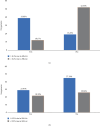Effects of Statin Therapy on Glycemic Control and Associated Factors Among Type 2 Diabetes Mellitus Patients in Northeastern Tanzania: A Retrospective Cohort Study
- PMID: 40785972
- PMCID: PMC12334290
- DOI: 10.1155/jdr/6626154
Effects of Statin Therapy on Glycemic Control and Associated Factors Among Type 2 Diabetes Mellitus Patients in Northeastern Tanzania: A Retrospective Cohort Study
Abstract
Introduction: Statins have been implicated in poor glycemic control among patients with diabetes mellitus (DM), prompting the US Food and Drug Administration (FDA) to update warning labels on all statins to reflect the risk of increased blood glucose levels. However, few studies from sub-Saharan Africa have assessed this concern. This study investigated the effects of statins on glycemic control among patients with Type 2 diabetes mellitus (T2DM) in Kilimanjaro, northeastern Tanzania. Materials and Methods: This was a hospital-based retrospective cohort study evaluating changes in glycated hemoglobin (HbA1c) at 1-3, 7-12, and 19-24 months, as the primary outcome, comparing statin users and nonusers among T2DM patients attending DM clinic at Kilimanjaro Christian Medical Centre in Tanzania. Binomial regression models were fitted to calculate adjusted risk ratios for independent predictors of a ≥ 0.2% rise in HbA1c, with statistical significance set at p < 0.05. Results: Out of 122 patients, 51 (41.8%) were on statin therapy. Among these, 46 (90.2%) were prescribed atorvastatin. Statin users had an increase of mean HbA1c from 10.6% ± 2.7% at baseline compared to 11.6% ± 2.8% at 1-3 months (p = 0.114), followed by a decrease to 10.1% ± 2.2% at 7-12 months (p = 1.0), and 10.0% ± 2.5% at 19-24 months (p = 1.0). However, atorvastatin users (n = 46) had a significant increase of mean HbA1c from 10.7% ± 2.8% at baseline compared to 11.9% ± 2.7% at 1-3 months (p = 0.04). In contrast, nonstatin users had a consistent and significant decrease in HbA1c from 11.3% ± 2.8% at baseline compared to 9.7% ± 2.2% at 1-3 months (p = 0.001), to 9.7% ± 2.6% at 7-12 months (p = 0.011), and to 9.3% ± 2.2% at 19-24 months (p = 0.001). Conclusion: Statin therapy among patients with T2DM was associated with short-lived worsening of glycemic control at 1-3 months posttherapy.
Keywords: Tanzania; Type 2 diabetes mellitus; dyslipidemia; glycated hemoglobin (HbA1c); glycemic control; statins.
Copyright © 2025 Daniel P. Mujuni et al. Journal of Diabetes Research published by John Wiley & Sons Ltd.
Conflict of interest statement
The authors declare no conflicts of interest.
Figures




Similar articles
-
Treatment of periodontal disease for glycaemic control in people with diabetes mellitus.Cochrane Database Syst Rev. 2015 Nov 6;2015(11):CD004714. doi: 10.1002/14651858.CD004714.pub3. Cochrane Database Syst Rev. 2015. Update in: Cochrane Database Syst Rev. 2022 Apr 14;4:CD004714. doi: 10.1002/14651858.CD004714.pub4. PMID: 26545069 Free PMC article. Updated.
-
In Search of the Ideal Resistance Training Program to Improve Glycemic Control and its Indication for Patients with Type 2 Diabetes Mellitus: A Systematic Review and Meta-Analysis.Sports Med. 2016 Jan;46(1):67-77. doi: 10.1007/s40279-015-0379-7. Sports Med. 2016. PMID: 26604100
-
Treatment of periodontitis for glycaemic control in people with diabetes mellitus.Cochrane Database Syst Rev. 2022 Apr 14;4(4):CD004714. doi: 10.1002/14651858.CD004714.pub4. Cochrane Database Syst Rev. 2022. PMID: 35420698 Free PMC article.
-
Improvements in Glycemic Control With a Digital Diabetes Logbook: Secondary Analysis of a Randomized Controlled Trial Enriched by Observational, Real-World Data.J Med Internet Res. 2025 Jun 30;27:e68933. doi: 10.2196/68933. J Med Internet Res. 2025. PMID: 40587847 Free PMC article.
-
Glycaemic and Weight Control in People Aged 65 or Younger Newly Diagnosed with Type 2 Diabetes in Spain: Insights from the PRIORITY-T2D Study.Adv Ther. 2025 Jul;42(7):3354-3368. doi: 10.1007/s12325-025-03230-7. Epub 2025 May 19. Adv Ther. 2025. PMID: 40388088 Free PMC article.
References
MeSH terms
Substances
LinkOut - more resources
Full Text Sources
Medical
Miscellaneous

